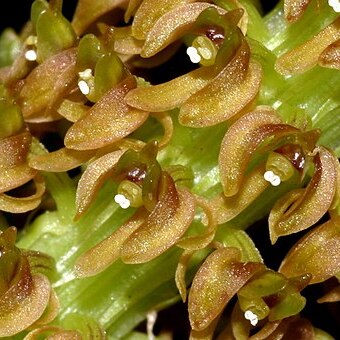Herbs, terrestrial or rarely epiphytic. Roots hairy. Stem cylindric, fleshy, often creeping and rooting in basal part, thickened into ovoid or conic pseudobulbs which are sometimes enclosed by scarious sheaths. Leaves 2 to several, thinly textured, plicate, petiole sheathing at base. Inflorescence apical, erect, racemose, unbranched; floral bracts persistent, lanceolate or setose. Flowers not resupinate or resupinate, green, brown, yellow, pink, or purple. Dorsal sepal spreading, free; lateral sepals free or fused, spreading. Petals often narrower than sepals, free, spreading; lip parallel to column, sometimes concave at base, entire or lobed, lacking auricles at base, apical margin entire or toothed, lacking a spur, callus absent, cushionlike or obscurely transversely ridged. Column lacking a foot; anther cap dorsal, attached by a broad filament, locules opening ventrally; pollinia 4, in pairs, clavate, waxy; stigma semicircular or transversely elliptic; rostellum obtuse at apex.
More
Deciduous terrestrial orchids with short, above-ground, fleshy stems that are replaced annually by a new shoot arising from a basal node of a previous years stem, or from the top of an upright rhizome, the old stem rotting away. New roots are produced from the base of the new stem. The leaves, which arise on the upper nodes, are relatively broad, thin-textured and pleated. Inflorescences are terminal on a stem and four-sided or winged. They carry small, non-resupinate flowers which have broader sepals than petals. The short, broad, mostly 3-lobed labellum has prominent basal lobes (auricles) resembling spurs that project behind the short column, and a tooth-like or strap-like apex. Labellum apex can be entire or coarsely toothed.
Loamy soil and litter in moist forests, especially rainforest, and sheltered humid situations in more open habitats.

